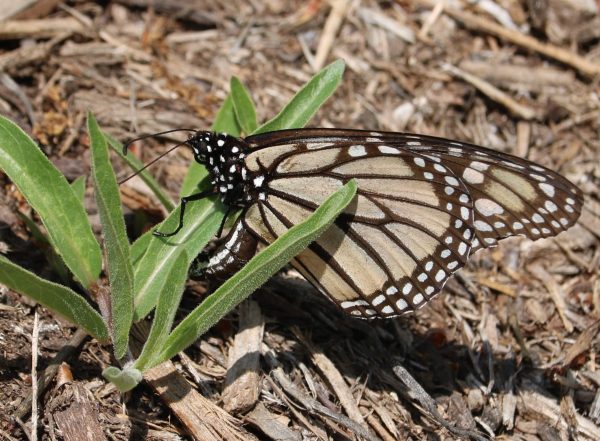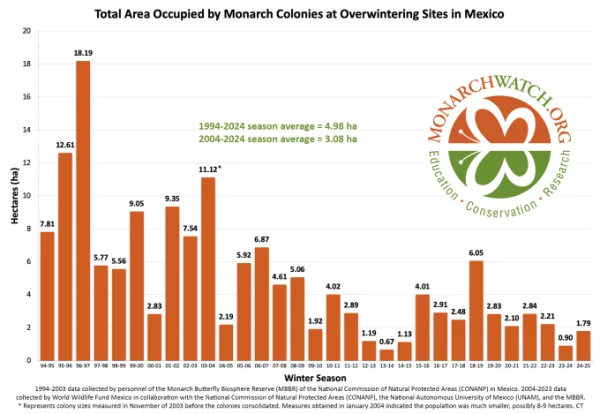The eastern migratory population of monarch butterflies increased 99% this season over last year’s second worst count since records have been kept, the World Wildlife Fund (WWF) and the National Commission of Protected Natural Areas in Mexico (CONANP) announced yesterday.
The news arrived as the butterflies’ legal status as “threatened” under the Endangered Species Act (ESA) is pending. Comments on the petition will be open until March 12. After that, U.S. Fish and Wildlife Service has until next year to specify details of the ruling.
The eastern monarch butterfly population is typically calculated by counting the number of hectares the butterflies occupy in the overwintering roosts in the mountains west of Mexico City. This year, the count tallied 1.79 hectares, or about 4.42 acres.
Scientists estimate that each hectare represents 21.1 million butterflies, based on a 2017 study. And many argue that the current counting system is far from perfect, given that the density of the butterflies is not universal on all trees.
Using the 21.1 million number, the eastern migratory population in Mexico numbered 37.76 million butterflies.
News regarding the West Coast monarch monarch population was not not good this year.
In January, the Xerces Society for Invertebrate Conservation, which spearheaded the original ESA listing back in 2014, announced that their annual Western Monarch Count revealed only 9,000 monarchs overwintering in the tree groves in coastal California. That number ranks as the second lowest count ever recorded and represents a sharp decline from the past three years, when more than 200,000 overwintering western monarchs were observed annually.
Despite the boost in the eastern population, many argue that monarchs are in trouble and their pending ESA listing status as “threatened’ is long overdue.
“Monarch butterflies face numerous threats, but their recovery is possible through widespread, collaborative conservation action,” Monarch Joint Venture, a monarch butterfly conservation organization announced on their website.”Supporting the monarch migration requires engagement from all land use sectors across North America,”
“While an increase is great news, the numbers in Mexico are still well below historic norms,” said Scott Black, director of the Xerces Society for Invertebrate Conservation, in a press release on the organization’s website. Black added that with the western monarch population that overwinters in California also in decline, “we urgently need better protections for this beloved butterfly.”
Chip Taylor, founding Director of Monarch Watch, a monarch conservation organization that oversees the insects’ citizen science tagging program, expressed a more hopeful outlook.
“A takeaway here is that monarchs demonstrate resilience over and over again. Weather knocks them down, but spectacular recoveries are the rule if negative conditions during one year are followed by favorable conditions for population growth,” Taylor wrote on the Monarch Watch blog.
World Wildlife Foundation (WWF) Mexico chose to use the news as a rallying cry.
“Eastern monarch butterfly population nearly doubles in 2025/Protection of forests where monarchs overwinter also improves,” read the headline and subhead on the March 6 story.
To accentuate the positive, the photograph accompanying the announcement showed a solid orange-and-black cloud of monarch butterflies fluttering from the earth.
“It’s now time to turn this year’s increase into a lasting trend with an all-hands approach where governments, landowners, conservationists, and citizens continue to safeguard critical habitats along the monarch’s North American migratory route,” said Jorge Rickards, director general of WWF Mexico.
As monarchs head north in search of milkweed and nectar, prospects in Texas do not look inviting.
Pervasive drought and a recent freeze have stunted spring growth in much of the state, especially in West and South Texas, often the butterflies first egg laying stop on their journey north in the spring. Ferocious winds have also fueled wildfires, halting sprouting forbes in their tracks.
“Nothing’s blooming, since we had that freeze a week and a half ago,” said Drake White, owner of the Nectar Bar native plant nursery in San Antonio and a long time monarch butterfly follower. Spring migrants are seeking nectar and milkweed, the host plant on which they lay eggs that will launch this year’s first generation of monarchs.
“If they come now, there’s slim pickings,” said White.
TOP PHOTO: Faded monarch butterfly lays eggs on Antelope horns milkweed in March of 2020. –Photo by Monika Maeckle
Related articles
- Commercial butterfly breeders brace for devastating hit as monarch ESA listing looms
- Monarch butterflies listed as “threatened” under the Endangered Species Act
- A tense online debate: raising monarch butterflies at home
- New study: monarch migration at risk, monarch butterflies are not
- USFWS rules monarch butterflies worthy of protection, but they don’t have resources to protect it
- As ESA listing looms, new study challenges dogmatic narrative that monarchs are in decline,
- “Weird” weather has scientists concerned about this year’s monarch butterfly migration.




WWF only counts Monarchs over-wintering in the Monarch Butterfly Reserve. Since there are other documented roosting sites in other Oyamel forests, MBR counts are an estimate but shouldn’t be relied upon as THE source for policy making. Example peer-reviewed paper on other over-wintering sites: Pérez-Miranda, Ramiro; Arriola-Padilla, Victor Javier; and Romero-Sanchez, Martin Enrique. “Characterizing New Wintering Sites for Monarch Butterfly Colonies in Sierra Nevada, Mexico.” Insects, 2020, Volume 11, Issue 6, June 21, 2020. https://www.mdpi.com/2075-4450/11/6/384
I am surprised by the 99% increase because the fall migration last year across the Midwest and in Texas was noticeable smaller than in 2023 migration so the 2024-25 overwintering population in Mexico should have been smaller as well.
If the 99% increase is accurate then the spring migration into the Midwest this coming Spring should be stronger than the Spring 2024 migration. During the next 3 months we shall see whether it will be or not.
Monika , I appreciate all you and your group do, I enjoy knowing what’s going on with the butterflies 🦋, I’m praying all the insects survive this year, Thank You .